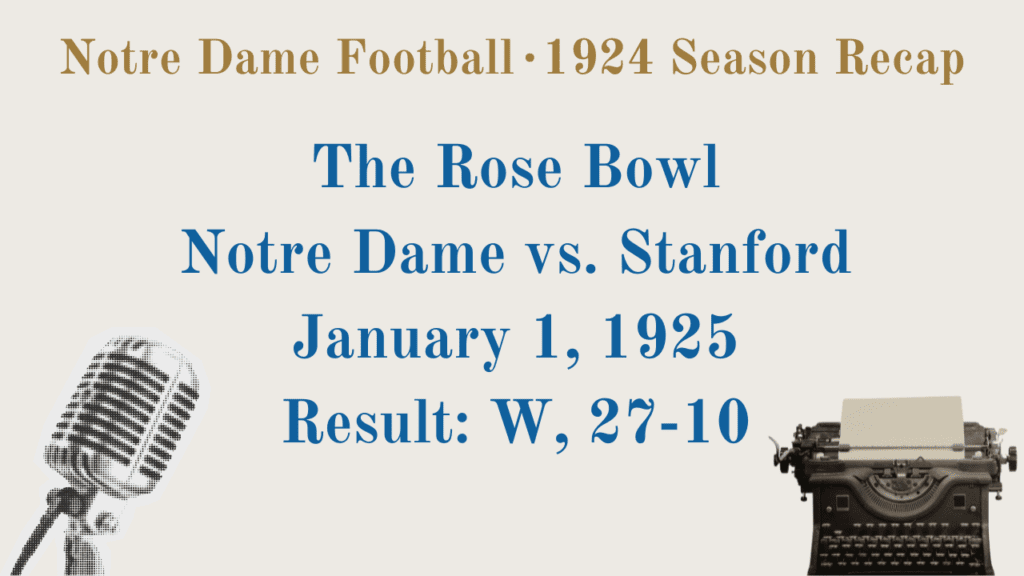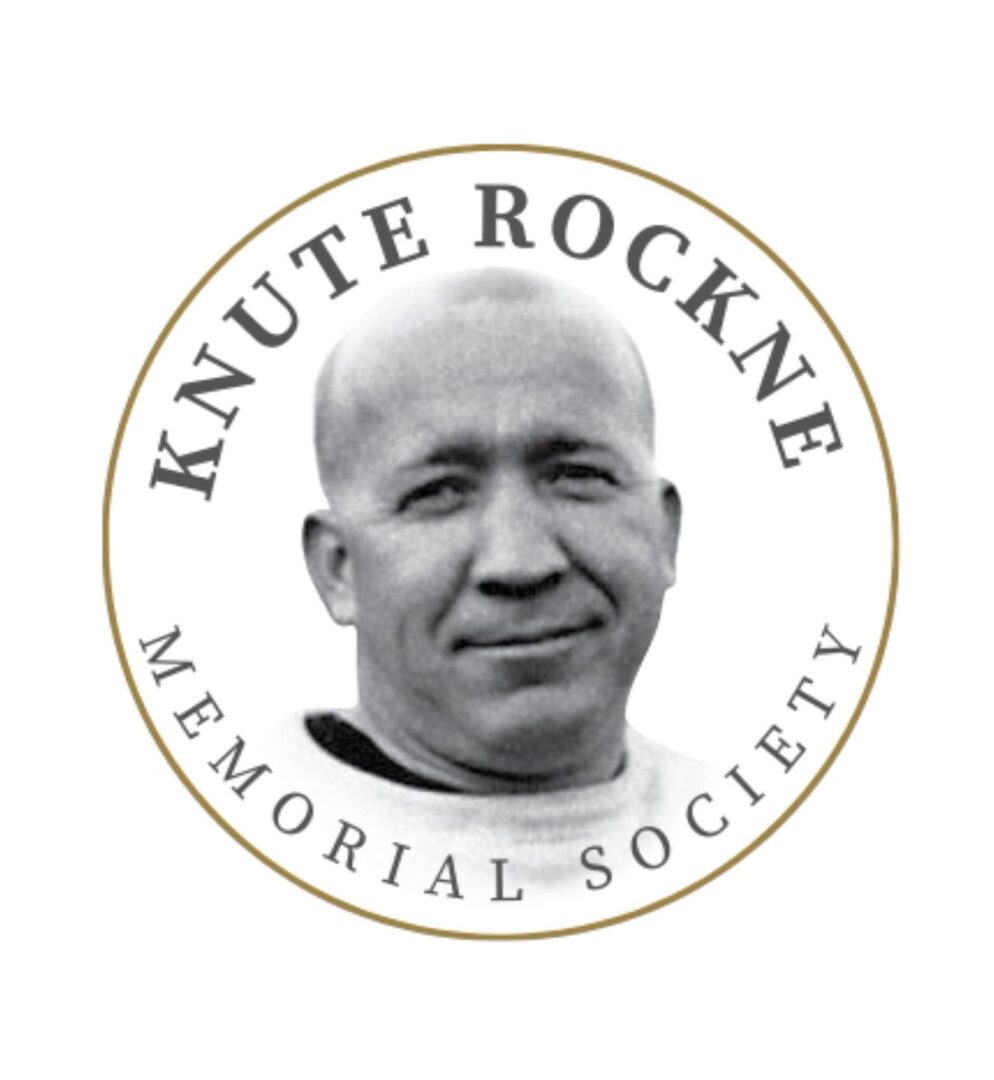
Notre Dame vs. Stanford
January 1, 1925
Notre Dame’s trip to the Jan. 1, 1925, Rose Bowl was unlike any bowl trip before or since. Instead of embarking on a direct route to Pasadena, Knute Rockne and his Irish made a three-week, circuitous journey to and from California, putting the team in front of thousands of new and would-be fans across the nation.
From Chicago, the team made a brief stop in Memphis, then overnight visits to New Orleans, Houston and Tucson. At each location, there were banquets, Masses said by local prelates, sight-seeing events and other opportunities to mix with Notre Dame alums and the general public. The trip was also designed to slowly acclimate the Irish to warmer weather, though that plan was stymied by record cold in New Orleans and Houston.
When Knute Rockne stepped off the train in Tucson, he looked up at a bright blue sky and broke into a wide grin, rubbing his hands together in anticipation. Finally, the Irish had encountered the mild weather he had hoped for. Minutes later, after a member of the welcoming committee gave him the schedule of receptions, dinners and banquets, his mood darkened. Rockne thought that his club was already showing the physical and psychological effects of too many feasts on the trip and that the players needed a different regimen. His hosts explained that special care was being taken to feed his players healthy food and allow them plenty of rest, and he again smiled and gave his approval.
The team would spend four days in Tucson, and no place on the tour was more excited to be hosting the Irish. The University of Arizona offered thorough accommodations, including use of all its athletic facilities, especially its well-maintained football field. Coach J. Fred “Pop” McHale, who had guided the school’s football team since 1914, was known and respected by Rockne. On December 27, 1,500 local fans were watching the Irish at their first workout on the university field.
Three days later, the Irish received a rousing sendoff from hundreds of their new-found friends in Tucson. The high school band played the Victory March and the players were showered with confetti as they boarded the train. “While in the city,” the local paper declared, “the Notre Dame party won a host of friends and supporters. Tucson…is backing Notre Dame players to win by a good margin.”
In Glenn Scobey “Pop” Warner of Stanford, the Irish would face one of the most experienced, accomplished and innovative coaches in college football history. The wily veteran had seen almost everything in his 30 years as a college coach – and much he had developed himself. The spiral pass, the spiral punt, numbered plays, the dummy scrimmage, the double-wing formation, the unbalanced line were all the creative work of Warner. And now he guided a skilled, veteran Stanford eleven, led by the singularly strong Ernie Nevers.
Nevers had grown up the youngest of seven children in a family that operated dining rooms and boarding houses in several locations near the western end of Lake Superior in Ontario, Wisconsin and Minnesota. They moved to Santa Rosa, California, where he finished high school before entering Stanford in 1922. Warner’s offense was designed to get the ball into Nevers’ hands nearly every play. He was almost unstoppable as a bruising running back, accomplished as a passer and punter and ferocious on defense.
On game day at the magnificent new stadium, Stanford was expected to have the edge in color and student support. There would be a full rooting section including 1,100 Stanford students, equipped with brilliantly colored cards and organized stunts. A 72-piece Stanford band was preparing to march in the Tournament of Roses parade and to accompany the rooting section at the game. Notre Dame would need to rely mainly on its support within the general admission audience as well as the attending alumni.
For millions of fans across the country, the game would enter their homes via radio broadcasting, with four stations providing coverage. A direct wire from the field in Pasadena to the WGN studios in Chicago was to be relayed to WCBS in New York, resulting in “the first time in radio history that Eastern stations have broadcast direct a Pacific coast event.” Across the Midwest, telegraph offices in countless towns and cities planned to remain open on the holiday to receive reports from Pasadena. By all accounts, the game would be the most widely followed in the history of football.
Rockne had been vague about who he planned to start, but the answer came when the Shock Troops ran out into kickoff formation. Harry O’Boyle kicked off and started in the backfield with Eddie Scharer, Tom Hearden and Bill Cerney. The Shock Troops held Stanford to a missed field goal attempt on its first drive, and now it was time for the regulars. The crowd roared as they saw the “four horsemen” and “seven mules” take the field. On the first play from the Irish 20, Don Miller took the snap and started around left end, as he had so many times during the season. This time, though, he lost control of the ball and Stanford’s Johnston recovered on the Irish 17. They made it to the 11 on three plays, then kicked a field goal for a 3-0 Cardinal lead.
Notre Dame got rolling on its next possession, when Jim Crowley touched the ball for the first time and broke loose around end, tiptoeing along the sideline for a 20-yard gain. Two plays later, Crowley took off one way, reversed field and raced through flailing defenders to the Stanford 29. Don Miller hauled in a quick-strike pass from Harry Stuhldreher and dodged through the defense for another first down. Stanford, staggering from the rapidity of the Irish attack, called a timeout to slow the pace of the game down. But Notre Dame’s forces were relentless, as Miller drove behind Joe Bach at left tackle for 10 yards to the Stanford 9-yard-line.
The Cardinal rush stiffened, and it forced Stuhldreher to retreat some 20 yards before he lofted a a fourth-down pass that landed incomplete. Stuhldreher lay crumpled on the turf. A delay to attend to the “little general” gave both teams a chance to catch their breath after the frenetic action of the last few minutes. Finally, Stuhldreher rose to his feet, and although he limped badly, he stayed in the game. His Irish mates, agitated over his injury, lined up with resolve as Stanford took possession. During the break as the quarter ended, Joe Bach had a head injury taped, which Notre Dame believed to have been caused by a steel brace worn by a Stanford playler. A delay ensued while Rockne spoke with the officials, who ordered the brace removed.
With ND rooters on their feet, Crowley opened the period by taking the ball four yards to the Stanford 3. The Irish line snapped back into position briskly; Elmer Layden received the ball and charged toward the goal. A great mass of toppled bodies – some blue-clad and others red – obscured the line. Referee Thorp plunged into the melee of flailing limbs, located the pigskin and signaled a touchdown. ND led, 6-3.
Stanford then starting gaining steadily — everything old “Pop” tried seemed to be working. He was especially fond of plays that kept Cardinal backs wide in the backfield for a pass, then upfield once they had the ball. But the Irish were spotting the pattern, and it matched what Coach Slip Madigan of St. Mary’s – former Irish star — had told them in his scouting report. On a third-and-five from deep in Irish territory, Nevers faded and attempted a cross-field pass. Elmer Layden anticipated this play and perfectly timed a leap between two Cardinal targets. He snared the ball and dashed into an open field and waltzed into the end zone to complete a 78-yard play. Crowley made the kick and the Irish led, 13-3, at the half.
The Cardinal forced an early break in the second half when they partially blocked a Layden punt three plays into the third quarter. But a field goal try sailed wide, and later another fell short. On a Layden punt, the ball went directly to Stanford’s Fred Solomon. But the Cardinal quarterback bobbled the ball and it bounded away from him. Solomon dove for the ball but Chuck Collins brushed him aside, and Irish end Ed Hunsinger flew past, picking up the ball and racing 20 yards into the Cardinal end zone amid an escort of blue jerseys. Another huge Stanford miscue had resulted in Notre Dame’s 20-3 lead.
But the Cardinal had far too much pride to lie down. Nevers picked off a pass by Layden at the ND 29. The muscular blond was never more determined. Nevers gained four yards over tackle, two more at right guard, then plowed for a first down to the 16. He smashed for three more, then another five. A human battering ram, Nevers drove to the Irish six yard line. Then, with the Irish line bunched, he reared back and hit Shipkey with a short pass for a touchdown. The kick sliced Notre Dame’s lead to 20-10, and the third quarter ended a minute later.
As the fourth quarter slid by, Stanford and Nevers never quit. The Cardinal drove deep into Irish territory. A touchdown here could cut the lead to three points. Nevers had to have the ball. He dragged Irish tacklers for four yards to the 2. Another play gained a yard. Nevers made a half-yard dash – fourth down inside the 1-yard line. Adam Walsh encouraged his mates as they bunched together on the Irish goal line. They had a pretty good idea of who was headed their way. Nevers took the snap, smacked into the ND wall and fell forward. Harry Stuhldreher ignored the piercing pain in his ankle and drove his 152-pound frame into the pile. The stack of gridders was untangled and revealed the football – less than six inches short of the goal line. Notre Dame ball. Stanford hearts sank.
Minutes later, Layden intercepted a desperate heave by Nevers at the Notre Dame 37 and summoned the energy to outrun a beaten Stanford eleven 63 yards for a clinching touchdown. Crowley’s kick made it 27- 10 and Irish fans everywhere knew that the game was over. Almost all the Shock Troops re-entered the game. The gun sounded and the battle of the ages was history.
Notre Dame had survived the knockout punches of a great opponent, made the most of its opportunities and capped its most memorable season to be truly crowned with glory.
Excerpted from Loyal Sons: The Story of The Four Horsemen and Notre Dame Football’s 1924 Champions. Order an inscribed, autographed copy of the Special Centennial Commemorative Edition HERE.
